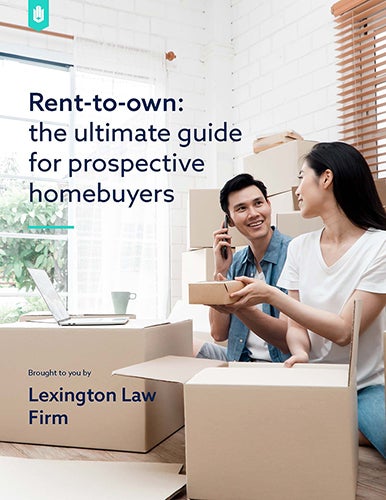
The information provided on this website does not, and is not intended to, act as legal, financial or credit advice. See Lexington Law’s editorial disclosure for more information.
Rent-to-own is an appealing option for many prospective homebuyers, especially those who don’t yet qualify for a mortgage. However, it isn’t suitable for everyone. It’s essential to recognize the advantages and drawbacks of rent-to-own so that you can make an informed decision for yourself. Keep reading for a comprehensive outline of the pros and cons of rent-to-own.
What is rent-to-own?
Rent-to-own is a contract that allows the renter to buy the house they’re renting after a certain period of time has passed. In this contract, a portion of the rental payments that have been made will go toward the home purchase. Additionally, the contract usually stipulates what the home’s price will be when the lease ends. At the end of the lease, the renter acquires a mortgage for the property and finalizes the sale.
In return for being given the opportunity to purchase the home, the renter pays higher-than-average rent and a one-time, nonrefundable option fee of between three and seven percent of the home’s total price. For example, if you’re purchasing a home for $300,000, a five percent option fee would be $15,000.
Lastly, rent-to-own contracts come in two types: lease-option and lease-purchase. A lease-option contract allows you to decide if you want to buy the home at the end of the contract. You won’t get your option fee back or the higher rent you paid, but you can walk away from the deal. In contrast, a lease-purchase locks you into buying the property at the end of the contract. So, if for some reason you change your mind or can’t get approved for a mortgage, there may be legal and financial consequences for not following through with the purchase.
Pros of a rent-to-own home
Here are the positives of having a rent-to-own contract:
1. You don’t have to wait for improved finances
Ultimately, most people who opt for a rent-to-own contract are close to getting a mortgage but there is something holding them back. With Rent-to-own, the contract allows a person to move into the house they potentially want to buy without waiting for their finances to improve.
2. You can build equity
One of the top reasons people consider rent-to-own is for the equity. Many people hate renting because the money they pay toward the rent doesn’t contribute to their equity and financial growth. A rent-to-own contract will often stipulate how much of your rent payments go toward your future home purchase, which allows you to build equity while you rent.
For example, let’s say your rent is $1,500 a month for a one-year rent-to-own contract. Your contract states that $250 a month goes toward your home purchase. So at the end of the agreement, you’ll have $3,000 in equity.
3. You don’t have to buy the house if you don’t want to
If you have a lease-option agreement, you can still decide not to buy the property at the end of the lease. This is an added luxury as you get to live in the property without total commitment. Sometimes, people purchase homes and later find out that they don’t like the neighborhood or learn that the house has problems. A lease-option doesn’t lock the person in, so they still have the flexibility to decide not to buy the property at the end of the agreement.
Note that this isn’t true for a lease-purchase agreement.
4. You can lock in the house price
A rent-to-own contract often (although not always) stipulates what the price of the house will be at the end of the lease. If the local housing market increases during your rental period, you’ll still get the benefit of purchasing the home at a great price.
Cons of a rent-to-own home
Here are the downsides to a rent-to-own contract:
1. You might lose money
Due to fees and rent credits, you might end up losing money in the deal if you don’t purchase the house in the end. You’ll have paid a nonrefundable option fee that was probably thousands of dollars, in addition to higher-than-average rent for your entire lease length.
Additionally, if you sign a lease-purchase agreement, and you can’t purchase the home—you don’t get approved for a mortgage—you might be subject to fees.
Lastly, if the owner gets foreclosed on while you’re living there, you might also be unable to purchase the home and lose money.
2. You might have to pay more fees
If you’re planning to buy a property, it’s essential to be prepared for all the other fees that come with homeownership, like property taxes, maintenance fees and HOA fees.
Make sure you negotiate all parts of your contract and understand them thoroughly. For example, many rent-to-own contracts have the renter pay for half or all of the home repairs during their lease. If you do so and don’t end up purchasing the property, that was money spent without any benefit to you.
3. You might have to purchase the house
If you’re in a lease-purchase agreement, you may have to buy the house at the end of the lease even if you no longer want it. You’re locked into this decision even if you decide the home isn’t to your liking, you don’t enjoy the area or you want to move to an entirely different city.
Whenever possible, opt for a lease-option agreement so you have some flexibility.
4. You aren’t guaranteed financing
You might pursue a rent-to-own situation because you’re under the assumption that you’ll be able to secure financing and move ahead with the purchase at the end of the agreement. However, if your credit score drops, you fall into financial trouble or mortgage approval requirements change, you might not get your financing at the end of the lease. If this happens, you risk spending all that extra money without the benefit of future homeownership.
Try to keep your credit score high, continue to save for a down payment and monitor the mortgage approval rules in your state.
5. You have to be careful about what you agree to
You have to be careful because less-than-trustworthy rent-to-own programs do exist. Some of the most common rent-to-own problems are:
- The home has expensive issues that will be costly to fix, such as foundational issues. Get a home inspection before signing a rent-to-own contract.
- The owner has a history of being foreclosed on or a list of tenants with complaints. Try to research the owner to see if there are any outstanding or previous complaints against them.
- The contract stipulates a price that’s too high. Get a home appraisal so your contract isn’t pricing you above fair market value.
- The contract protects the seller more than the buyer. Have a lawyer or a real estate agent review your agreement to ensure your best interests are protected.
Who should consider rent-to-own?
Despite some of the drawbacks, rent-to-own is the right choice for many people. In particular, the following people should seriously consider rent-to-own:
- Those who want to test out homeownership
- Those who want to test out a city or a neighborhood before purchasing
- Those who want their monthly payments to go toward building home equity and not rent
- Those who can’t make a sizable down payment or who have nontraditional incomes
- Those with poor credit or without significant savings
If you don’t fit into any of these categories, or if the potential downsides of rent-to-own are too concerning for you, then rent-to-own might not be for you.
For more information on rent-to-own, examples of contracts, red flags to look out for and ways to shop for the best deal, download the Complete Rent-to-Own Guide for Prospective Homebuyers.
What to do if you choose to pursue rent-to-own
Now that you know the pros and cons of rent-to-own, you can better decide if you want to pursue this kind of housing. If you’re interested in a rent-to-own contract, make sure you protect yourself in the process. Always do your research of the property, the area and the seller, and get a home inspection and a home appraisal.
Additionally, don’t sign anything you don’t understand. If you want to, you can work with professionals to make sure the contract protects you. Most importantly, don’t forget to negotiate. You can negotiate the option fee, the amount of the rent payment that goes toward the future home purchase, the lease length, maintenance responsibilities and more. Remember to make sound financial decisions so that you’re ready for a mortgage when your rent-to-own period is over. You want your rent-to-own to turn into homeownership, so start analyzing and working on your credit today. Work with the credit professionals at Lexington Law to ensure your credit report is fair and accurate.
Note: Articles have only been reviewed by the indicated attorney, not written by them. The information provided on this website does not, and is not intended to, act as legal, financial or credit advice; instead, it is for general informational purposes only. Use of, and access to, this website or any of the links or resources contained within the site do not create an attorney-client or fiduciary relationship between the reader, user, or browser and website owner, authors, reviewers, contributors, contributing firms, or their respective agents or employers.
Lexington Law is not an RTO company. Any content provided on this website regarding the topic of RTO is nothing more than a resource Lexington Law believes might be helpful to readers of its website. Lexington did not write this content. It was provided by a third party. The information provided on this website does not, and is not intended to, act as legal, financial or credit advice; instead, it is for general informational purposes only. Use of, and access to, this website or any of the links or resources contained within the site do not create an attorney-client or fiduciary relationship between the reader, user, or browser and website owner, authors, reviewers, contributors, contributing firms, or their respective agents or employers. Lexington did not write this content. It was provided by a third party.

